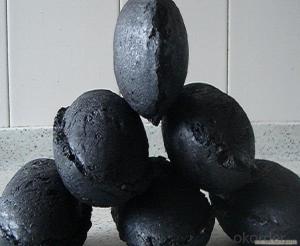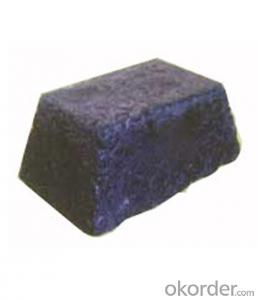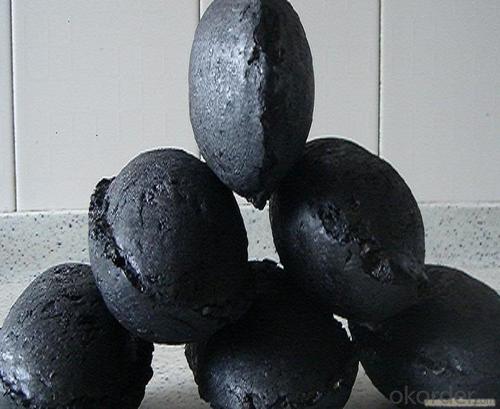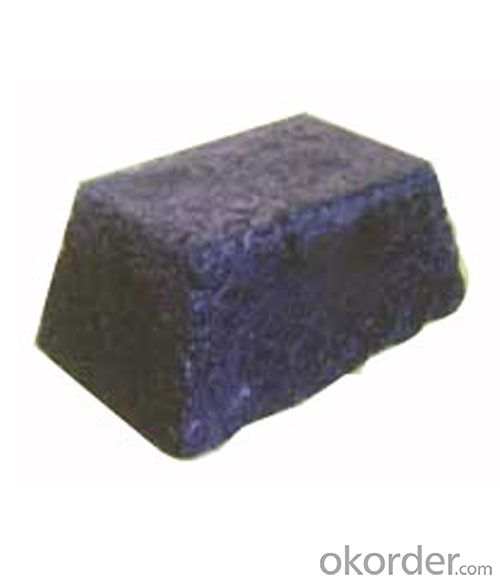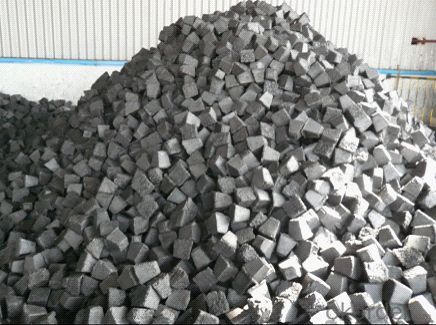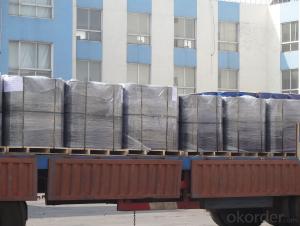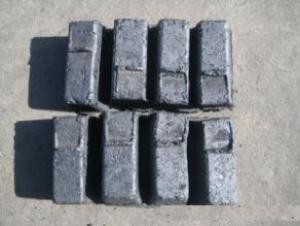Carbon Electrode Paste -Ash9/Low Ash CNBM Product
- Loading Port:
- Tianjin
- Payment Terms:
- TT OR LC
- Min Order Qty:
- 0 m.t.
- Supply Capability:
- 100000 m.t./month
OKorder Service Pledge
OKorder Financial Service
You Might Also Like
Product Description
Carbon Electrode Paste is a self-baking electrode used in submerged arc furnaces for delivering power to the charge mix. Electrode Paste is added to the top of the electrode column in either cylindrical or briquette form. As the paste moves down the electrode column the temperature increase causes the paste to melt and subsequently bake forming a block of electrically conductive carbon. Electrode Paste is essentially a mix of Electrically Calcined Anthracite (ECA) or Calcined Petroleum Coke (CPC) with Coal Tar Pitch.
Packaging & Delivery
Packaging Details: | 1.1MT jumbo bag or as your requirment |
Delivery Detail: | 15 days after receiving advance payment or LC |
Spcifications
1:carbon eletrode paste
2:for ferroalloy,calcium carbide manufacture
3:HS 3801300000,YB/T5212-1996,ISO9001:2008
Graphite/Carbon Electrode Paste
Specification/Item | ||||||
Ash | 4.0%max | 5.0%max | 6.0%max | 7.0% Max | 9.0% Max | 11.0% Max |
VM | 12.0%-15.5% | 12.0%-15.5% | 12.0%-15.5% | 9.5.0%-13.5% | 11.5%-15.5% | 11.5%-15.5% |
Compress Strength | 18.0Mpa Min | 17.0Mpa Min | 15.7Mpa Min | 19.6Mpa Min | 19.6Mpa Min | 19.6Mpa Min |
Specific Resistance | 65μΩm Max | 68μΩm Max | 75μΩm Max | 80μΩm Max | 90μΩm Max | 90μΩm Max |
Bulk Density | 1.38G/CM3 Min | 1.38G/CM3 Min | 1.38G/CM3 Min | 1.38G/CM3 Min | 1.38G/CM3 Min | 1.38G/CM3 Min
|
- Q: What are the different types of carbon fibers?
- There are several different types of carbon fibers, including standard modulus carbon fiber, intermediate modulus carbon fiber, high modulus carbon fiber, and ultra-high modulus carbon fiber. These types vary in their strength, stiffness, and cost, making them suitable for different applications and industries.
- Q: Why carbon 14 can be used to measure the age of matter?
- Then, after the death of the animal's plant, because carbon 14 is a radioactive isotope, still continue to decay, death of plants and thus reduce carbon 14 content in a day. 14 the amount of carbon can be determined by measuring the radioactivity. The half-life of carbon 14 for 5730 years, after 5730 years, the amount of carbon 14 only half. Radiocarbon method is the most commonly used method of archaeology, it can be concluded that the year for up to 50000 years.
- Q: How does carbon affect food production?
- There are several ways in which carbon impacts food production. Firstly, carbon dioxide (CO2) plays a vital role in photosynthesis, the process by which plants convert sunlight into energy and produce oxygen. Insufficient levels of carbon dioxide hinder plant growth and food production. However, excessive carbon emissions from human activities, such as the burning of fossil fuels, have led to increased concentrations of CO2 in the atmosphere. Initially, this can stimulate plant growth, but without a proper balance of essential nutrients, it can result in nutrient imbalances and reduced crop quality. Secondly, carbon is a crucial element in soil organic matter, which is essential for soil fertility and health. Soil organic matter retains moisture, enhances soil structure, and provides a habitat for beneficial microorganisms. Higher carbon levels in the soil promote healthier plant growth, increase nutrient availability, and improve water-holding capacity. Unfortunately, unsustainable agricultural practices like excessive tilling and deforestation deplete soil carbon, leading to decreased fertility, erosion, and reduced food production. Moreover, the rise in carbon emissions has contributed to global climate change, resulting in extreme weather events such as droughts, floods, and heatwaves. These events have devastating consequences for food production. Droughts reduce water availability, making it difficult for crops to grow, while floods can wash away entire harvests. Heatwaves damage crops, reduce yields, and increase the prevalence of pests and diseases. Climate change also alters rainfall patterns, affecting planting and harvesting schedules and disrupting agricultural systems. Furthermore, carbon emissions contribute to the acidification of oceans. The increased CO2 in the atmosphere leads to higher levels of dissolved carbon dioxide in seawater, forming carbonic acid. This acidification disrupts marine ecosystems, affecting the food chain and impacting fish populations, which serve as a crucial protein source for many people. To mitigate the negative impacts of carbon on food production, it is essential to reduce carbon emissions and transition to more sustainable agricultural practices. This includes adopting climate-smart farming techniques like agroforestry, conservation agriculture, and organic farming. These practices promote carbon sequestration in soils, reduce greenhouse gas emissions, enhance biodiversity, and improve soil health. Additionally, investing in research and development of climate-resilient crop varieties and improved irrigation systems can help minimize the effects of climate change on food production.
- Q: What is carbon nanotechnology?
- Carbon nanotechnology involves the study and manipulation of carbon-based materials at the nanoscale, typically in the form of carbon nanotubes, fullerenes, or graphene. It focuses on harnessing the unique properties and structures of these carbon materials to develop innovative applications in various fields such as electronics, medicine, energy, and materials science.
- Q: How does carbon contribute to air pollution?
- Carbon contributes to air pollution primarily through the emission of carbon dioxide (CO2) and carbon monoxide (CO) into the atmosphere. The burning of fossil fuels, such as coal, oil, and natural gas, releases large amounts of carbon dioxide, a greenhouse gas that contributes to global warming and climate change. This increased level of CO2 in the atmosphere traps heat, leading to the greenhouse effect and subsequent rise in global temperatures. Additionally, incomplete combustion of fossil fuels and biomass can release carbon monoxide, a toxic gas that can have detrimental effects on human health. Carbon monoxide is particularly dangerous as it binds to hemoglobin in the blood, reducing its oxygen-carrying capacity and potentially causing asphyxiation. Furthermore, carbon-containing compounds such as volatile organic compounds (VOCs) contribute to air pollution. VOCs are released from various sources, including industrial processes, vehicle emissions, and the use of solvents in paints and cleaning products. These compounds react with other pollutants in the atmosphere to form ground-level ozone, a major component of smog. Ozone can cause respiratory problems, eye irritation, and other health issues when inhaled. In conclusion, carbon contributes to air pollution through the emission of carbon dioxide, carbon monoxide, and volatile organic compounds. These pollutants have significant impacts on climate change, human health, and the overall quality of the air we breathe. It is crucial to reduce carbon emissions and adopt sustainable practices to mitigate the negative effects of carbon on air pollution.
- Q: What is carbon black filler?
- Carbon black filler is a type of material made from fine particles of carbon that is added to various products, such as rubber, plastics, and inks, to improve their strength, durability, and color.
- Q: How does carbon affect the quality of soil?
- Carbon plays a crucial role in improving the quality of soil. It enhances soil fertility by serving as a food source for beneficial microbes and earthworms, which aid in breaking down organic matter and releasing essential nutrients. Additionally, carbon improves soil structure and water-holding capacity, promoting better root growth and reducing erosion. Overall, the presence of carbon in soil is vital for its health and productivity.
- Q: How does carbon impact the productivity of marine ecosystems?
- Carbon impacts the productivity of marine ecosystems in several ways. One of the main ways is through ocean acidification. When carbon dioxide from human activities is released into the atmosphere, a significant portion of it gets absorbed by the oceans. This excess carbon dioxide reacts with seawater to form carbonic acid, leading to a decrease in the pH of the ocean. This increase in acidity has detrimental effects on many marine organisms, especially those that rely on calcium carbonate to build their shells or skeletons, such as corals, shellfish, and some plankton species. Ocean acidification inhibits the process of calcification, making it difficult for these organisms to develop and maintain their protective structures. This not only affects their survival but also impacts the entire food chain. Many species rely on these calcium carbonate structures as a food source or for shelter, so a decline in their productivity can have cascading effects on the ecosystem. Additionally, increased carbon dioxide levels in the ocean can also affect the metabolism and physiology of marine organisms. Some studies have found that elevated CO2 concentrations can impair the growth, development, and reproductive success of certain species. This can lead to a decrease in overall productivity within the ecosystem. Furthermore, climate change, driven by the accumulation of carbon dioxide in the atmosphere, also impacts marine ecosystems. Rising temperatures can disrupt the delicate balance of marine ecosystems, affecting the distribution and abundance of species, altering predator-prey relationships, and leading to changes in the timing of vital ecological events such as spawning or migration. These changes can have profound impacts on the productivity of marine ecosystems, as different species may struggle to adapt or compete under new conditions. In conclusion, carbon dioxide emissions have far-reaching consequences for marine ecosystems. Ocean acidification and climate change, driven by excessive carbon dioxide, have detrimental effects on the productivity of marine ecosystems, affecting the growth, survival, and reproductive success of marine organisms. The impacts of carbon on marine ecosystems highlight the urgent need to reduce greenhouse gas emissions and mitigate the effects of climate change to protect these fragile and vital ecosystems.
- Q: What are the effects of carbon emissions on the stability of desertification?
- Carbon emissions contribute to the stability of desertification by exacerbating its effects. Increased atmospheric carbon dioxide levels lead to global warming, which in turn intensifies droughts and reduces precipitation in arid regions. This prolonged dryness accelerates soil degradation, reduces vegetation cover, and undermines the ability of arid ecosystems to sustain life. Therefore, carbon emissions play a significant role in destabilizing desertification processes and further threatening the stability of arid landscapes.
- Q: Today in the market to buy Yuba, instructions have such a word that I don't understand, please master Zhijiao: carbon fiber after energized carbon molecule formation of Brown movement, this movement can be effective in most of the electrical energy into the far infrared.
- When it is energized, its motion intensifies, the frequency becomes V2, and the frequency becomes larger, the vibration system is unstable and the frequency is back to its original frequency. So you have to release energy in the form of electromagnetic waves. I am not too clear about the specific release process. I know that the molecules do slow motion and generate additional electromagnetic waves. The frequency of the extra electromagnetic wave emitted is v2-v1, and its frequency falls in the far infrared region.
Send your message to us
Carbon Electrode Paste -Ash9/Low Ash CNBM Product
- Loading Port:
- Tianjin
- Payment Terms:
- TT OR LC
- Min Order Qty:
- 0 m.t.
- Supply Capability:
- 100000 m.t./month
OKorder Service Pledge
OKorder Financial Service
Similar products
Hot products
Hot Searches
